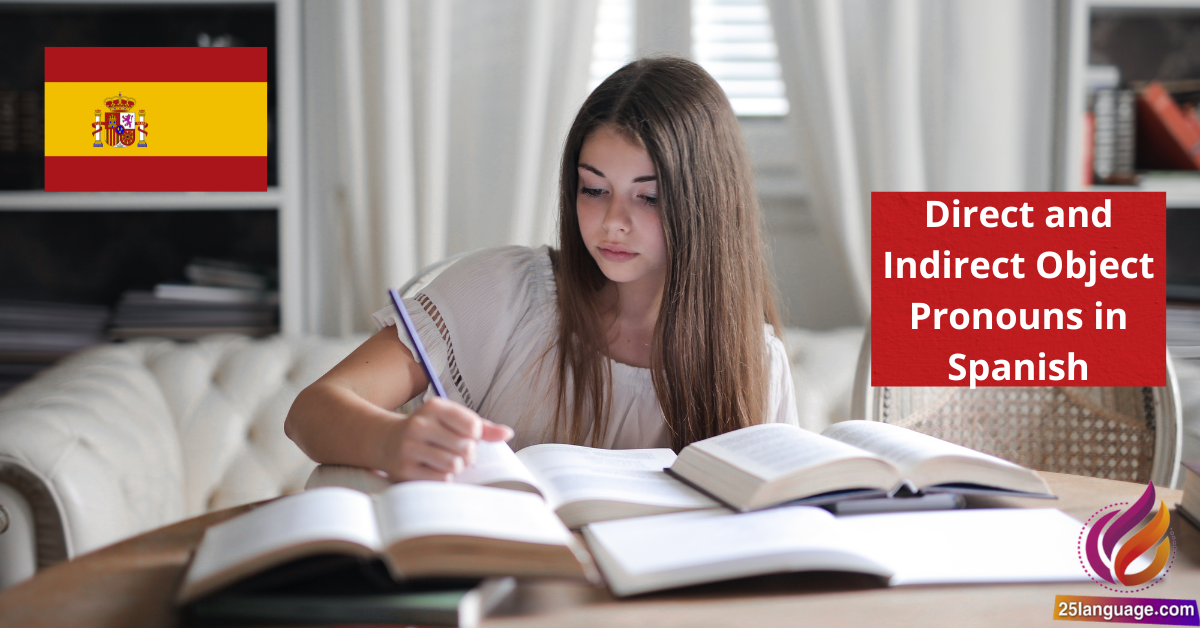Direct and Indirect Object Pronouns in Spanish

Mastering Spanish opens the door to vibrant conversations, and understanding direct and indirect object pronouns is key to speaking like a native! These pronouns allow you to simplify sentences and enhance your dialog skills. In this lesson, you’ll learn how to replace nouns with pronouns, making your speech fluid and effortless. whether you’re ordering food or sharing stories, grasping these essential elements will elevate your Spanish to new heights!
Mastering Spanish Object Pronouns for Clarity in Communication
In Spanish, object pronouns are essential for achieving clarity and brevity in communication. they replace the nouns that receive the action of the verb, helping avoid repetition. The primary object pronouns include:
- me – me
- te – you (informal)
- lo – him, it (masculine)
- la – her, it (feminine)
- nos – us
- os – you all (informal, plural)
- los – them (masculine)
- las – them (feminine)
Such as, consider the sentence “I see Juan.” In Spanish, this becomes “Yo veo a Juan.” if we wish to replace “juan” with a pronoun, we can say “Yo lo veo” (I see him). Another example is “I give the book to Maria,” which translates to “Yo le doy el libro a Maria.” With the use of an object pronoun, it transforms into “Yo se lo doy” (I give it to her), where “lo” replaces the book and “le” refers to Maria in the indirect construction.
| Spanish Example | object Pronoun | English Translation |
|---|---|---|
| Yo veo a Juan. | lo | I see Juan. / I see him. |
| yo le doy el libro a Maria. | se lo | I give the book to Maria. / I give it to her. |
Understanding Direct and Indirect Object Pronouns Through Engaging Examples
In Spanish, understanding direct and indirect object pronouns is essential for effective communication. Direct object pronouns replace the noun that directly receives the action of the verb, whereas indirect object pronouns replace the noun that indirectly receives the action. To clarify, here are the direct object pronouns: me (me), te (you), lo/la (him/her/it), nos (us), os (you all), los/las (them). For instance: Yo veo a María. (I see María) can be transformed into Yo la veo. (I see her), where ‘la’ is the direct object pronoun replacing ‘María’.
On the other hand,indirect object pronouns indicate to whom or for whom something is done. The indirect object pronouns are: me (to me), te (to you), le (to him/her/you formal), nos (to us), os (to you all), les (to them). For example: Ella da un libro a Juan. (She gives a book to Juan) can be expressed as Ella le da un libro. (She gives him a book), where ‘le’ refers to Juan. This distinction is vital as it helps you construct sentences that are both grammatically correct and meaningful.
| Spanish Example | Pronoun Type | English Translation |
|---|---|---|
| Yo veo a Juan. | Direct Object | I see Juan. |
| Yo lo veo. | Direct Object Pronoun | I see him. |
| Ella da un regalo a Ana. | Indirect Object | She gives a gift to Ana. |
| Ella le da un regalo. | Indirect Object Pronoun | She gives her a gift. |
Practical Tips for Using Object Pronouns Effectively in Spanish
In Spanish, object pronouns replace nouns to avoid repetition and make sentences more fluid. Ther are two types of object pronouns: direct and indirect. Direct object pronouns answer the question “what?” or “whom?” in relation to the verb,while indirect object pronouns answer “to whom?” or “for whom?” Here are the direct object pronouns:
- me (me)
- te (you,informal)
- lo (him/it,masculine)
- la (her/it,feminine)
- nos (us)
- os (you all,informal)
- los (them,masculine)
- las (them,feminine)
For example,in the sentence “Yo veo a Juan” (I see Juan),you can replace ‘Juan’ with the direct object pronoun: “Yo lo veo” (I see him). Similarly, consider indirect object pronouns such as:
- me (to me)
- te (to you, informal)
- le (to him/her/you, formal)
- nos (to us)
- os (to you all, informal)
- les (to them)
In the sentence “Ella da el libro a Maria” (She gives the book to maria), the indirect object pronoun can be used: “Ella le da el libro” (She gives her the book). Remember that the placement of these pronouns can be before the conjugated verb or attached to an infinitive or gerund. This adaptability helps create varied sentence structures.
| Spanish Example | Object Pronoun Rule | English Translation |
|---|---|---|
| Yo veo a Juan. | Direct object pronoun: “lo” | I see Juan. |
| Yo lo veo. | Using “lo” as a pronoun | I see him. |
| Ella da el libro a Maria. | Indirect object pronoun: “le” | She gives the book to Maria. |
| Ella le da el libro. | Using “le” as a pronoun | She gives her the book. |
Navigating Object Pronouns to Enhance Your Spanish Language Skills
In Spanish, object pronouns are essential for making your sentences more concise and natural.these pronouns replace the noun that is the object of the verb, allowing for smoother communication.There are two types of object pronouns: direct and indirect. Direct object pronouns answer the question “what?” or “whom?” regarding the verb, while indirect object pronouns answer the question “to whom?” or “for whom?” Here is a rapid overview of the direct object pronouns: me (me), te (you), lo (him, it – masculine), la (her, it – feminine), nos (us), os (you all), los (them – masculine), las (them – feminine). Such as:
- ¿Ves a Juan? Sí, lo veo. (Do you see Juan? Yes, I see him.)
- Comí la torta. La comí toda. (I ate the cake. I ate it all.)
On the other hand, the indirect object pronouns in Spanish include: me (to me), te (to you), le (to him/her/it), nos (to us), os (to you all), les (to them). Indirect object pronouns frequently enough accompany verbs that imply giving or communicating something. For instance:
- Ella me da un regalo. (She gives me a gift.)
- Les compré flores a mis amigos. (I bought flowers for my friends.)
| Spanish Example | Type of Pronoun | English Translation |
|---|---|---|
| lo veo. | Direct Object Pronoun | I see him/it. |
| La comí toda. | Direct Object Pronoun | I ate it all. |
| Me da un regalo. | Indirect Object Pronoun | She gives me a gift. |
| Les compré flores. | Indirect Object Pronoun | I bought them flowers. |
Key Takeaways
hemos explorado juntos el fascinante mundo de los pronombres de objeto directo e indirecto en español. Recordemos que los pronombres de objeto directo, como “lo”, “la”, “los” y “las”, se utilizan para reemplazar a los sustantivos que reciben directamente la acción del verbo. Por otro lado, los pronombres de objeto indirecto, como “me”, “te”, “le”, “nos” y “les”, sustituyen a los sustantivos que reciben el beneficio o el daño de la acción.
ahora que tenemos una comprensión más clara de cómo funcionan estos pronombres, los animamos a practicarlos en su vida diaria. Traten de usarlos en conversaciones, en la escritura y en ejercicios para reforzar lo que han aprendido. La práctica constante es clave para mejorar en un nuevo idioma, y cada pequeño esfuerzo cuenta.
No se desanimen si al principio les resulta un poco complicado; es parte del proceso de aprendizaje. ¡Recuerden que cada paso que dan los acerca más a la fluidez en español! Sigan explorando, practicando y no duden en hacer preguntas. ¡Estamos seguros de que lograrán dominar los pronombres de objeto en español y mucho más! ¡Ánimo y a practicar!





























